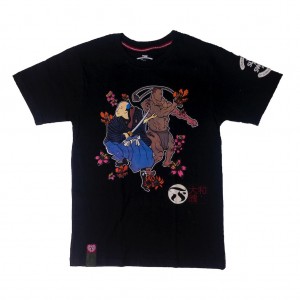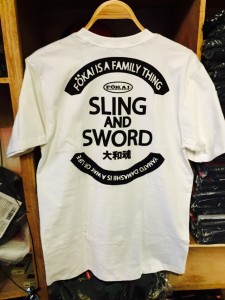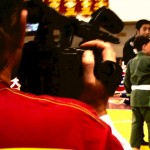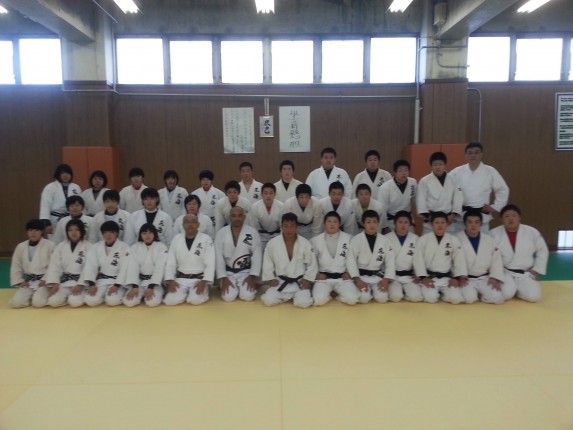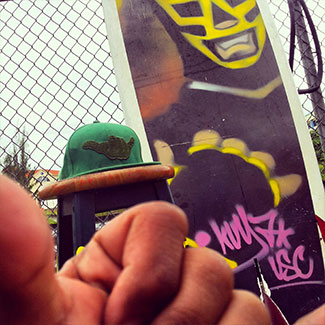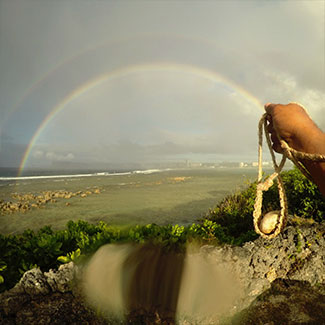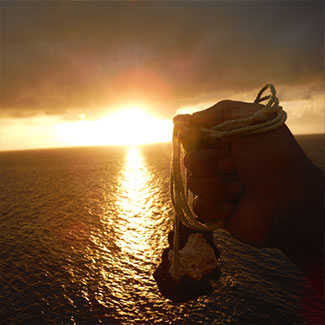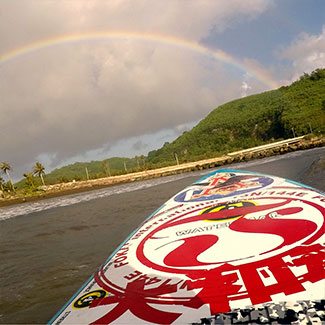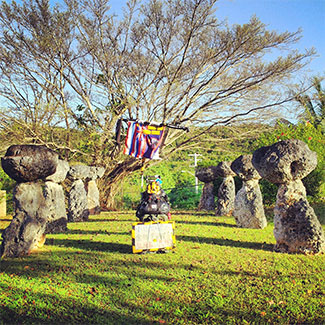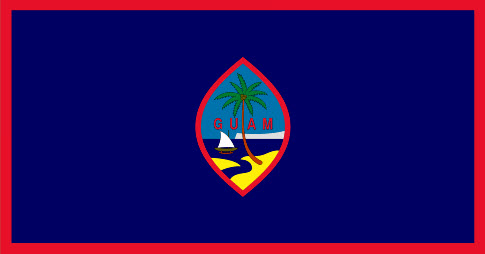Para I Onra: The Ana Varu
During a trip visiting Ireland in 2010, I was with Tony Susuico(another Guam native) enjoying the view from a cliffside overlooking the famed Cliffs of Moher. There we met an old Shepherd (who at one time was a sailor) who was also walking the Cliffs and, in the midst of a hello and good conversation had given him a Fokai Sticker with the coordinates 13 North /144East..He read the sticker and quickly narrowed down the location first to Micronesia and then soon the Mariana Islands.
From there he connected the Mariana Islands with the Flying Proa and told us of its legendary status among seafaring men from all parts of the world.. This was the oddest and most random thing. Although we were surprised that he was able to narrow down the location as well as his familiarity with the Flying Proa It wasnt until years later, reflecting on this experience that its gravity had really set.
Its pretty amazing how a population so small and from a place so isolated that seafaring men n the other side of the world would know of our people through excellence as engineers and our proficiency as sailors. .
And its just as sad that despite this great accolade, its a craft and artform that our people f today are s separated from, that teh vast majority cant even recognize the mistake thats inside of the flag that we fly so proudly today.
t
Local seafarer prepares for Taiwan-Guam voyage
Local seafarer Ignacio Camacho recently returned to island from close to four months of training with a Chamorro proa in the Baltic Sea in preparation of a weekslong voyage from Taiwan to Guam.
Next year, Camacho will be taking part in the Rapa Nui Experiment, a voyage orchestrated by German adventurer Burghard Pieske.
Pieske plans to sail a traditional Chamorro-style proa from Taiwan to Easter Island, traveling with seafarers from the various Pacific islands across the ocean.
The voyage takes its name from the indigenous name of Easter Island, also called Rapa Nui.
Camacho will accompany Pieske on the first and longest leg of the trip between Taiwan and Guam.
The proa, which is named the ‘Ana-Varu, measures about 11 meters long, roughly 36 feet, and is modeled after the Chamorro-style proa.
The ‘Ana-Varu takes its name from a legendary Tahitian pillar of heaven and is also the Tahitian name for one of the three stars located in Orion’s belt.
Those stars also held significance for the original navigators in the Pacific, having different names across the various island nations.
The original Chamorro name is now unknown, Camacho said, but local navigators refer to them as “the three stars” or “the stars that are three.”
The stars’ importance will also carry over to this adventure.
“The interesting thing is I’ll be sailing ‘Ana-Varu in the direction of ‘Ana-Varu, the star, from Taiwan to Guam,” he said.
The proa takes other design elements from other Pacific nations.
At one end stands a miniature moai, the famous monolithic statues from Easter Island.
Camacho said the use of design elements from across the Pacific is symbolic of the trip itself.
“All of the peoples of the Pacific are related to each other in their voyages and in some of their origins,” said Camacho.
“And we all have different symbols and traditions but they all really add up to one thing: one Pacific peoples with a common past, a common history and a common culture.”
That idea gets to the whole point of the voyage.
“Burghard wants to not only show how the migration happened, but the fact that the outriggers of the many different types of people were what populated these islands and that these were absolutely beautiful craft even thousands of years ago,” he said.
Pieske also wants the voyage to “instill this sense of pride” in the people of the Pacific, he added.
Boat design
Although it takes its structural design from the Chamorro design, the ‘Ana-Varu has the advantage of modern materials, said Camacho.
The biggest difference, he said, is that the ‘Ana-Varu is designed to be sailed by two people, whereas traditional proas originally could require larger crews to maneuver and sail.
The most obvious difference is how the mast is adjusted.
Unlike western sailboats, a change in direction in a proa requires sailors to pick up the mast and move it to the opposite end of the vessel, a move referred to as shunting.
In a standard proa, Camacho said, this would require a team of sailors and a lot of rope.
Camacho and Pieske, however, took advantage of winches, pulleys and blocks that allow them to move the mast and adjust the sail.
He noted that it could also be sailed by a one-man crew if necessary.
Camacho recently spent four months in the Baltic Sea, north of Germany, practicing with the vessel.
That sea is renowned for its less-than-ideal sailing conditions, which is why they chose it for sea trials.
“It had large swells, some of the meanest waters in that small area that you can imagine,” he said.
Camacho said his experience sailing proas has involved lots of open “blue water” sailing outside the reef.
Having that experience with the Pacific’s wind and wave patterns coupled with the challenges he experienced in the Baltic, “is gonna make it seem quite easier” to make the trip next year, he said.
The voyage
The goal, Camacho said, is to officially launch the voyage in February, when sailing conditions will be ideal.
They’re estimating the trip to take any where from 21 to 36 days.
“Twenty-one days sounded like a good thing,” he said. “That’s three weeks on the open ocean. It sounded relatively comfortable.”
“We talk about three months on the open ocean? That might be a different story,” he added. “But that might happen; it’s possible.”
Pieske’s entire voyage to Easter Island could take up to three years. That would include stopovers of various lengths at Pieske’s Pacific waypoints.
Although Camacho is only committed to the first leg, he said he’ll be “on standby” in case Pieske needs another crew member during the trip.
Given that it’s the longest stretch of the voyage over open ocean, Camacho said, they have made sure to be “over-provisioned” for the trip.
During the voyage, Camacho said Pieske will be journaling as well as taking video and photographs of the trip.
If possible, he added, they hope to be able to provide real-time updates to those following the voyage.
Although they will likely have a GPS tracking beacon on board for safety reasons, Camacho said he’ll be using traditional navigational techniques to guide their way across the water.
“I’ll have nothing to do with modern tracking or modern navigation,” he said.
Camacho said he’s studying and learning navigation every day leading up to the trip.
That involves learning patterns of stars and tides to identify where they are and where they’re headed.
Raising awareness
The pair plans to arrive in Guam in time for the 2016 Festival of the Pacific Arts. Once here, the ‘Ana Varu will stay temporarily before Pieske continues the voyage.
Ultimately, Camacho said, he hopes the voyage raises awareness of Chamorro seafaring traditions not only worldwide, but also here in Guam.
Camacho called on residents to take interest in local seafaring groups and learn about their efforts to revive the ancient traditions, noting the importance it has for the island’s history.
“We are a very special kind of people like no other,” he said.
Cultivate the Spirit: The Sling
What is the ” Sling” in ” Sling and Sword”? and what is fokai’s connection to it?
The sling is a weapon used across the planet from thusands of years ago. Its not certain who had been the first ones to do it; its theorized that it might be one of those things that just kind of showed up at the same time in unrelated places.
Besides joining David in the ongoing fight against Goliath, Our main connection to slinging is through culture.
The sling is an ancient weapon of the early native Chamorros and it was something very activated within the community. Considering that the ancient Chamorro society may have been around as long as 5000 years..it’s amazing that still hikers, bystandres, and archaeologists still find (are gifted) them today.
When the Spanish invaded Guam in 1521, what might have started out as gift-trading, evolved into a war when the Spanish decided to colonize a very peaceful and happy Guam. The aspirations to spread Christianity and give Spain more property and power, came at the cost of the lives of tens of thousands of Chamorros who didnt want to give up their way of life to surrender fightlessly to the greedy foreginers.
The Chamorro people had fought incessantly for close to 75 years. it was with the mobility of the Flying Proa that allowed the island rebels to retreat and regroup to outer islands to reset forces, and their proficiency with the sling to fight Spanish forces from a distance.
After Guam had lost the war, the majority of Flying Proas were destroyed and the art of slinging was banned . The rise of gun powder and moderne weaponry would prove the need for the sling to be obsolete, and outside of a few–the art of slinging has disappeared from the masses and has been for the most part tucked away in the decaying pile of many of Guam’s old traditions.
The revival of the art of slinging has been a great way to reconnect with the ancestors of Guam and holds a great sybolism for the active efforts to exhibiting out islands positively and formidably to the world.
Sling&Sword
The Sling is Guams native weapon, the sword is Japans native weapon. Sling and Sword is a collaborative campaign between fokai and yamato damashii to celebrate the bridge between Guam and Japan through martial arts and a statement of fokai’s connectivity with Yamato Damashii through martial arts principles and service to defend and protect the good side of the Force
Team Matao , Invigoration, &The Inifresi
via www.guampdn.com
Less than 24 hours before their match against the top-ranked team in Asia, the Guam men’s national soccer team is focused and confident.
After touching down in Tehran, Iran on Tuesday, Team Matao met with local media and acclimated themselves to the local conditions. During an interview with the Guam Football Association media officer, Matao head coach Gary White complimented the hosts, but said his team will come to compete Thursday night.
“The players don’t fear them,” White said. “They respect them, but they don’t fear them and we’re really looking forward to the game.
Guam challenges Iran in the second round of the 2018 FIFA World Cup Qualifier in Iran at 12:30 a.m. Friday, Guam time.
attached is also a video clip of Team Matao–Sounding the Inifresi before a match in international competition
MATAO:
Ginen i mås takhilo’ gi hinasso-ku
I mås takhalom gi kurason-hu,
Yan i mas figo’ na nina’siña-hu,
Hu ufresen maisa yu’
Para bai prutehi yan hu difende
I HINENGGE,
I KOTTURA,
I LENGGUÅHI,
I AIRE,
I HANOM yan I TANO’ CHAMORU
Ni’ irensiå-ku direchu ginen as Yu’os Tåta,
Este hu afitma gi hilo’ I Bipblia yan I Banderå-hu,
-I Banderan Guåhan.
…In English…
From the inner-most recesses of my mind,
From deep within my heart,
And with all my might,
This I offer.
To protect and defend
The Beliefs
The Culture
The Language
The Air
The Water and The Land of the CHamoru.
My heritage come directly from God,
This I affirm on the Bible and my Flag
– The Flag of Guahan.
FSharp:Hafa Adai Authentic
July 20, 2015 by admin
Filed under Online Store, Onra, Product Development, ProductDevelopment
We got into the clothing venture because we saw that Guam needed a dedicated label and tasteful product that could present Guam to the world Respectfully. That was in 1997. Time has flown and almost 20years later, we have seen more than 100 local clothing label s rise since then with over 60currently in operation, 30 of these still extremely active with several of them with flagship stores and soaring! TREMENDOUS!!
It was filling the gap between sport and ambition with what we felt was fashionable and island-serving.
Today this is still the case but now there is a room full of labels standing ready, willing, and –more than ever–able to deliver.
The rise and breath of our local clothing industry is a win for Guam as whole. Its great to see our island having different creative options to share what might harbor their love for things local.
We had ventured into button shirts before doing shorts sleeve and some long sleeve flannels but only had them in occasional and sporadic releases. We crafted up some samples of button designs using local island prints, but still friends and family were referring to these as “Aloha Shirts”
Before going further–first let it be said that we have absolutely nothing against “Aloha”. Though The Mariana Islands is thousands of miles apart from Hawaii–we’ve always had a respect for their gravity and efforts in the water, We’ve appreciated their hospitality and perfect weather,; i_in many ways we’ve embraced Hawaii as a sister island.
But what we feel that what we celebrate local–shouldn’t be done so in a foreign tongue, nor do we have to use overseas images, or tuck ourselves away in the shadow of someone else’s identity to convey an island vibe r to manifest island treasures.
This is what F Sharp is for: To provide quality and comfortable island formal attire–with local elements as our staple to Share Guam as a paradise destination, a resilient people, and an asset to the world around us. We aim to greet with Hafa Adai authentic attire, and we aim to resonate this vibe engineered through an island-rooted lifestyle to suit the needs from the beach to the Bassllica and everywhere in between
ONRA: FOKAI & THE MARIANAS OPEN
ONRA: Fokai&theMarianasOpen
Hafa Adai,
Brazilian Jiujitsu arrived on Guam at a time when No Holds Barred Fighting and Gracie Jiujitsu were virtually synonymous. It was a time when fighting proficiency was previously defined almost exclusively by kicks and punches. It was a time where the surprise onslaught of Jiujitsu’s combat worth had its representatives hardly ever losing in professional and amateur full-contact fighting competition.
Jiujitsu had flipped the script forever changing the world’s approach to self-defense training. It was the infant days of the UFC and the awakening of the beast that professional MMA has become today
As the sport of No Holds Barred Fighting evolved into Mixed Martial Arts competition, the curtains of secret techniques and strategies were opened wide for a receptive world to walk through. Martial Arts evolved speedily beyond the confines of style versus style and more towards conditioning and strategy. In due effect the rules, regulations, and point scoring system expanded Jiujitsu from “the Gentle Art” of self-defense to one of the most demanding facets of combat sports, high-level athletics, and unprecedented hand-to-hand martial science today.
Though no longer as dominant in MMA competition today. Jiujitsu has been cemented as the art and science that most significantly changed martial arts forever–paving the way for a still-evolving multidimensional approach to fighting, and offering to the masses a comprehensible and ready-to-use system of self defense.…
The Marianas Open was created in the thick of Guam’s Mixed Martial Arts heyday, and at a time when Guam Jiujitsu’s ambition began to sprout towards the light of larger tournaments. Under the council of World Competition decorated Jiujitsu Instructor/competitor Mike Fowler and Spearheaded by the efforts of Steven Shimizu and Tony Bashaw, the event modeled itself consistently with the International Brazilian Jiujitsu Federation events and standards—preparing Guam Jiujitsu practitioners with a test model and launching pad into larger events throughout Asia, The United States and towards creating the drive for a Guam-based Jiujitsu World Champion.
In a time when Mixed Martial Arts was catapulting throughout the community, The Marianas Open started as a project to reset Guam back into basics and provide Guam with a preparatory event that would get our Jiujitsu competitors ready for larger tournaments. In the beginning, this extended hopes of a better training environment for our MMA hopefuls; but I n the process further distinguished Sport Jiujitsu from MMA competition. This effort has since expanded to evolve Jiujitsu far beyond the shadows of Mixed Martial Arts and into its own light.
Today , alongside the Copa De Marianas, its mission has been successful with its veteran competitors garnering medals and gold medal finishes in events across the world as well as the ADCC Combat Championships and the Jiujitsu World Championships. With the momentum of 14 successful events, the Marianas Open and Copa de Marianas serves as the Ultimate Gathering for Guam’s Jiujitsu and Submission Grappling Community.
This 12th edition of the MarianasOpen, with four Copa de Marianas to add inside of 10years in the making—–the vision of the promoters and long-time supporters
of the event has taken form.
GuamJiujitsu has fast improved to dominate tournaments in the Asian-Pacific region times over with more medals than we can count in the PanAsian Brazilian Jiujitsu and No-Gi tournaments in the Philippines and repeat outstanding individual and team performances in the TokyoOpen and Asian Open tournament in Japan.
Through the baby steps taken from the MarianasOpen, Guam athletes have been kept in a motion that has helped to elevate our athletes to the mats and even podiums of World BJJ Power tournaments such as the Pan-American Jiujitsu Championships, the Pan-Kids, the US Open, and even the World Championships in California.
As a longtime supporter of the Marianas Open, FokaiIndustries is taking this opportunity to salute the organizers, competitors, champions and sponsors of the Marianas Open for helping walk the steps for the positive footprints that Guam has placed firmly in World Jiujitsu today.
Onra,TheForce,&Frank”TheCrank”Camacho
We have watched Frank grow tremendously through his career in combat sports and his life as a martial artist. Making headlines from Saipan to Maryland, throughout Guam and the Philippines, Camacho has carried the flags of our islands proudly across podiums with title victories through Submission Grappling, Braziian Jiujitsu, and Mixed Martial arts in Asia, mainland America, and of course in the islands of Guam and Saipan. With past career highlights including a 1st place finish as a Blue Belt in the Brazilian Jiujitsu World Championships, trying out on national television for The Ultimate Fighter television series—Frank , the competitor, has evolved into a world class fighter athlete that is not only a by product of training with the best; it is also the direct effect of his character and fortitude to work beyond himself to do ethically whatever it takes to win.
Doing enough in his career to earn props and respect for a lifetime, at only 24years old “The Crank” still keeps his eyes on the prize. From his competitive demeanor and his ferocity in the mat and cage, its comforting t know that defender, upholder, and son of the islands still has his heart set on the prize of honoring and cultivating the islands that shines brighter than even the UFC gold.
This is a recent interview copied and pasted from The Marianas Variety with our future champ
“For generations our people have been fighting. It runs through our veins. To save our land, preserve our culture, and our daily life struggles. That’s what I fight for. I’m on a mission to show the world where these islands in the Pacific are.”
‘The Crank’ takes on tough Japanese foe
Frank “The Crank” Camacho kicks off his 2015 campaign against Japan’s lightweight shooto champion Yusuke Kasuya in the Pacific Xtreme Combat 47 on March 13 at the University of Guam Feldhouse in Mangilao.
Frank “The Crank” Camacho aims for his fifth straight win when he goes up against Japan’s lightweight shooto champion Yusuke Kasuya in Pacific Xtreme Combat 47 set on March 13 at the University of Guam Fieldhouse in Mangilao. Camacho is fresh from scoring a submission win by arm-triangle choke against Korean Jae Woong Kim last December. (Jon Perez)
The Camacho-Kasuya bout is one of the four featured undercard fights of the Jang Yong Kim-Yusuke Kachi headliner.
The 25-year-old Guam-born fighter (15-2, with 11 wins by knockout) said he has prepared and trained hard against Kasuya (8-2, with 1 KO victory), who is a known scrappy fighter.
“I’m most excited about this PXC 47 fight in particular because my opponent, Kasuya, is a scrapper. From watching his previous fights, he’s a tough guy that finishes fights,” posted Camacho on his Facebook page.
“These are the opponents I look forward to. I fantasize about the hard-tough fights ahead. I truly get the full Fokai experience. Exhaust the body, proceed the mind, and cultivate the spirit.”
Camacho added that tough foes like Kasuya pushes and challenges him to further raise his game.
“Tough opponents like Yusuke force me to rise to the occasion and dig down deep for that extra push, that extra round, that extra punch during training, these are the things that make me a better martial artist,” said Camacho.
Camacho said he’s in great shape as he has not stopped training since scoring a first-round submission win over Jae Woong Kim by arm-triangle choke in Trench Warz 18: Rock and Rumble in his return bout on Saipan last Dec. 12.
“I’m in killer shape, weight in on point, zero injuries, and no more ring rust. This fight is very important for the goals I’ve set for 2015,” added Camacho, who is aiming to someday compete and represent the Marianas in the Ultimate Fighting Championship.
“For generations our people have been fighting. It runs through our veins. To save our land, preserve our culture, and our daily life struggles. That’s what I fight for. I’m on a mission to show the world where these islands in the Pacific are.”
He thanked his family, fans, and his girlfriend, Sarah (Filush), for all the love and support they’ve shown throughout the years.
“Thank you to my hometown CNMI fans. On March 13th, I’m not competing alone; I have my island behind me. For all that love and support, thank you. Thank you all very much for believing in me and supporting me through everything.”
Onra:AbuDhabi Pro Qualifiers
Guam is almost 20 years into its timeline with Brazilian Jiujitsu and Mixed Martial Arts. From humble beginnings in the garages of Jiujitsu admirers lookign to learn the gentle art–the momentum has since spiraled above and beyond producing a growing submission grappling community, a by-product of a resurgence in Guam wrestling, Regional Champions, World Champions and children and women that can kick more ass than believable
With barely a year since its launching–CAULIFLOWER CULTURE, a clothing company dedicated to the lifestyle and culture where contact sports communities and fans come together, will be hosting the Abu Dhabi Pro Qualifiers on March 14th at the HotelNikko Guam
Heres an article copied and pasted from Guams leading newspublication with the Cauliflower Culture Founder, Mechor Manibusan regarding a Sheik’s interest in this tiny dot in the Pacific growing , without a doubt, as a landmark and fruitful destination for local and regional Jiujitsu opportunity…
‘It’s an amazing opportunity’: Local qualifier: Winners go to Abu Dhabi championship
Guam jiu-jitsu practitioners will have a shot to qualify for the prestigious Abu Dhabi World Professional Jiu-Jitsu Championship during a local event next week.
The Guam Pro Jiu-Jitsu Championships will be held at Hotel Nikko Guam on March 8. Winners of the 10 absolute divisions will be awarded entry and a paid trip to Abu Dhabi to compete at the world championship in April. Deadline to register is March 3.
“This is huge, man. It’s a huge tournament,” says UFC fighter and jiu-jitsu black belt Jon Tuck. “It’s an amazing opportunity. … (By qualifying) you already know you’re one of the best in the world, but being the top in the world is an unbelievable feeling.”
Tuck won a gold medal in the Open Light Division at Abu Dhabi in 2010 to become a jiu-jitsu world champion. He is not planning to compete at the Guam Pro because of a scheduled UFC fight in May.
The Guam Pro is a trials event run by the United Arab Emirates Jiu-Jitsu Federation, hosted locally by Melchor Manibusan.
“I hope the locals on Guam realize the magnitude of this event,” Manibusan said. “I would like our locals to realize the opportunity that’s on our island, take the opportunity and sign up.”
The Guam Pro provides the first opportunity a local jiu-jitsu practitioner could qualify for Abu Dhabi on island. Prior to this, Guam grapplers had to take a trip off-island to a trial.
The next world champion could now come from Guam without any travel expense. Prizes for the 10 divisions are valued at $8,000 per, Manibusan said, making the Guam Pro’s total purse about $80,000.
Absolute winners receive entry to the 2015 Abu Dhabi World Professional Jiu-Jitsu Championship, event registration, flight from Guam to Abu Dhabi, accommodations, meals, transportation, insurance and a travel visa.
“I kind of feel like that this is one of the largest events that’s happened,” says Gabe Baker, head instructor at Carlson Gracie Jiu-Jitsu Academy, Guam. “… I was expecting something big would come to Guam, I just wasn’t expecting it to be Abu Dhabi.”
On the Carlson Gracie whiteboard, just below the quote, “Losers quit when they’re tired, winners quit when they’ve won,” is a reminder to the students to sign up and compete at the Guam Pro.
“It’s every day preached,” Baker said. “Some of my guys were planning to go to Pan-American, but then when this came up it changed their mind.”
Several fighters are expected to come from off island to Guam just to compete in the Guam Pro, Manibusan said, because it is one of the last qualifying tournaments in the world for Abu Dhabi.
Timing not ideal
The timing is not ideal locally, as it comes just three weeks before the largest jiu-jitsu tournament on island, the Marianas Open, but the Guam Pro is adults only and there is still plenty of time between the two tournaments for grapplers to compete, rest, recover and train again.
“Marianas is a very big event and I didn’t want to do it the same month as them, but if I didn’t do this on March 8 I wouldn’t have done it at all,” Manibusan said.
The idea of a Abu Dhabi Trials on Guam seemed impossible only a year ago, but Manibusan had a few coincidental interactions that made it possible.
Last year Manibusan founded Cauliflower Culture, a contact sport apparel company that grew aggressively last year at jiu-jitsu and mixed martial arts events across the U.S. mainland.
In July Manibusan set up a Cauliflower Culture stand at the UFC Fan Expo in Las Vegas. At another booth sat Sheikh Mohammed bin Zayed Al Nahyan, a key figure in Abu Dhabi grappling.
The sheikh helped found the Abu Dhabi Worlds in the late 1990s and Manibusan was invited to compete there in 1999. Their relationship started to fade until Manibusan and bin Zayed reconnected at the UFC event.
From there they exchanged emails, talked about hosting a pro trial on Guam and worked to firm up the details. The event was locked in place last October during the World Jiu-Jitsu Expo at the Long Beach Convention Center in California.
“From competing and now, a decade later, working with them, is cool to me,” Manibusan said. “…We talked about it and we’ve done it and it’s here. They’re brining the Abu Dhabi World qualifiers here to Guam.”
The Guam Pro will have multiple weights for each belt in male and female divisions. After the weight medals are decided, the absolute divisions will decide the Abu Dhabi qualifiers
Prizes will be awarded to under 75-kilogram (about 165 pounds) and over 75-kilogram absolute winners in the men’s blue and white belt, purple belt and brown and black belt divisions. The women’s absolute weight cutoff is under and over 65-kilograms (about 143 pounds), with prizes going to winners of the white and blue belt division and the purple, brown and black belt division.
Requirements
Weigh-ins will be the day of the event at 8 a.m. Fights are scheduled to begin at Hotel Nikko at 9 a.m. There must be at least eight competitors in each division to qualify for the Abu Dhabi prize, Manibusan said.
Practitioners must be registered at a UAEJJF-certified gym to sign up for the Guam Pro. Registration is $100 and can be completed online at UAEJJF.org/event/info/122.
“We’re so blessed to have the Abu Dhabi Pro,” Tuck said.
Sinceeversince:PurebredJiujitsu
HEres a video interview were sharing from Sirena Mafnas. Its an interview on some good core questions with Stephen Roberto, the Head Instructor of PUREBRED JIUJITSU:Guam’s original,most qualified, and longest standing Jiujitsu Academy
1 pair (size 34) blue fight trunks
3 oval patches
3 femme tees (small)
1 femme tank (large or medium)
1 femme tote bag.
ONRA:GuamJiujitsuServesJapan
When Jiujitsu first started on Guam, the absence of a Jiujitsu Academy enticed us to learning the other grappling arts to enhance our very limited jiujitsu game. We had enrolled into Freestyle Wrestling and Judo training in hopes of not only learning their techniques but also for extra mat time after practice. Inconsistent combat philospohies with our Judo instructors often widened any gap that might have existed between Judo and Jiujitsu on Guam. The growth of Jiujitsu in effect, had worked completely independently and more than 15years later still–the best of Guam Jiujitsu is yet to gel with Guam’s highly resourced national Judo program. . Almost two decades worth later, Stephen Roberto travels to Japan to open an affiliate Jiujitsu academy in Sapporo when ironically…Guam Jiujitsu made larger moves in WorldJudo than it ever had before. Heres an article copied and pasted fromt eh Pacific Daily News on Roberto’s adventure in Japan
Roberto builds bridges: Rival martial arts open to learning from each other
0 Comments
Taught judo black belts: Purebred Jiu-Jitsu Guam lead instructor Stephen Roberto demonstrates a crucifix armbar on Mark Pangelinan. The crucifix armbar is one of the moves Roberto showed Tokai University judo students during a clinic held recently in Japan. Grant Wieman/Pacific Daily News/gwieman@guampdn.com
Purebred Jiu-Jitsu Guam lead instructor Stephen Roberto, a black belt in his sport, recently was invited to a teach a ground-breaking clinic to the judo team at Tokai University in Japan.
The opportunity came about at the last minute, Roberto said, but it was too monumental to pass up.
“To be invited is unprecedented,” Roberto said. “I got Facebook messages from all over the world for doing that. I’m not a judo black belt. For me to get invited as a Brazilian jiu-jitsu black belt made waves in the sport.”
The invitation was part of a new wave in judo, Roberto said, where the traditionally conservative, strict sport has begun to open up to new possibilities. That includes trying to pick up tips from jiu-jitsu, a rival sport that has traveled a different historical course.
Jiu-jitsu was once a major martial art in Japan, Roberto said, used primarily for self-defense, but it became less important in the past few centuries and with that, judo started to grow.
National power
Judo, a martial art used almost exclusively in sporting competition, is now much more popular in Japan, and Tokai University is the national power. A number of world champions, including two-time champion Hitoshi Sugai, have honed their craft at Tokai.
“In my martial arts career, especially here on Guam, Tokai University is known as an elite judo — strictly judo — university,” Roberto said. “A lot of the guys that graduate and do well on the college circuit and at Tokai are more than likely going to get recruited for the Japanese national team.”
Roberto is no stranger to conducting jiu-jitsu clinics. He’s traveled to several countries, including Japan, Ireland and the Philippines, to do just that.
But his turn in judo class was a new one, and it came as a surprise.
In late February, Roberto was in Sapporo, Japan, visiting Yoon Sugawara, a friend and former student who is opening a Brazilian jiu-jitsu affiliate gym there. The two had planned to host coaches from the Tokai University judo team, but time conflicts forced a change of plans.
Because of the respect Roberto has in the martial arts world, Tokai decided it couldn’t pass up the opportunity to see what skills he could share with its judo team.
Invitation
Sugai, now the technical director for Tokai University judo, invited Roberto to team training the next day.
“I didn’t even know what they wanted me to show,” Roberto said. “They told me they’d show me the next day. … That was the first time that I ever taught in a non-Brazilian jiu-jitsu setting. And, of course, they’re all black belts. That was just super intimidating.”
Language barrier
Roberto admits that his ability to speak Japanese is “bad, at worst,” but he wasn’t concerned about trying to instruct in a language he was unfamiliar with.
He showed jiu-jitsu techniques, slightly modified to comply with judo rules, and said the students picked it up easily.
“Grappling on the mat is like communicating with each other. You can kind of get what they’re saying” Roberto said. “They were familiar with the position, but they took the new details that I showed them. They took it openly.”
Roberto spent the first four years of his martial arts career as a judo student, but he said he moved away from the sport because the strict rules and impracticality to everyday life made it unappealing to him.
He’s always respected the sport, though, even as he’s become a black belt in rival jiu-jitsu, but working with the students at Tokai gave him a new appreciation for where judo is heading.
“I want people to understand that it’s not a bad rivalry, it’s good, but just give jiu-jitsu the respect it’s deserved,” Roberto said. “That thinking inside the box and not being able to think outside the box in judo? Now that box is crushed. They’re open now. They’re opening their eyes, they’re opening their minds and that’s a good thing.”
Evolution
“That shows that they want the sport to evolve and they’re finally giving jiu-jitsu the credit it deserves. To me, that’s a very big achievement. I think that’s the biggest thing that could happen.”
Roberto said he hopes he can continue the relationship and build bridges, not just between the two arts, but between Guam and the rest of the martial arts community worldwide.
That’s a two-way street, and while he shared techniques, he also took lessons away from Tokai.
Most notably, he said, is the work ethic and dedication to their craft the students there have.
Mutual respect
The mutual respect he shares with his Japanese judo counterparts will now have a base to grow from.
“In Japan, the way they train is very tough. They’re elite-level athletes,” Roberto said. “I’m blessed and grateful. Everything happens for a reason. I’m that kind of thinker.
“It says (Guam) is recognized for its martial arts athletes. People recognize my gym brand. More importantly, all that stuff is connected back to Guam.”
Professor Stephen Roberto tells of seminar in Japan
Mar 05, 2014
Today was a a special day in my jiu jitsu career. I was invited by the head coaches of Tokai University to conduct a seminar on ground techniques. I was so honored and humbled by this. The rivalry between judo and jiu jitsu has been ongoing. To be invited by the powerhouse university in Japan to share technique is an incredible opportunity. I shared my turtle guard attacks and guard passing systems to a grateful and eager squad who I later found out are their “A” team. 2 hours of technique followed by one hour of intense sparring. They were impressed by my teaching and even more impressed as I held my own with high level black belts and then to find out that I’m 39yrs old! I was invited back at the end of training and look forward to helping bridge the gap between bjj and judo. And its not every day were I get to teach a room full of black belts! Full room so I couldn’t fit everybody in the pic. #bjj #judo #jiujitsu #tokaiuniversity #newaza #grappling #japan #blackbelt #technique #tatame #bjjunitedtacteam #nsbjj #purebredbjjguam #yamatodamashii

